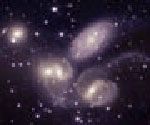This area deals with the fundamental laws and building blocks of nature and how they interact, the properties and the behavior of matter, and research into space and time and their structures.
innovations-report provides in-depth reports and articles on subjects such as astrophysics, laser technologies, nuclear, quantum, particle and solid-state physics, nanotechnologies, planetary research and findings (Mars, Venus) and developments related to the Hubble Telescope.

Precision placement may help in building nanoscale devices
In an effort to put more science into the largely trial and error building of nanostructures, physicists at the Commerce Department’s National Institute of Standards and Technology (NIST) have demonstrated new methods for placing what are typically unruly individual atoms at precise locations on a crystal surface. Reported in the Sept. 9, 2004, online version of the journal Science, the advance enables scientists to observe

University of California scientists working at Los Alamos National Laboratory have developed a theory describing light pulse dynamics in optical fibers that explains how an interplay of noise, line imperfections and pulse collisions lead to the deterioration of information in optical fiber lines. The theory will help to enhance the performance necessary for high-speed optical communication systems like video on demand and ultra-broadband Internet, and the research has helped establish a new field of

A small unmanned observatory high on the Antarctic plateau provides the best star-viewing site on Earth, according to research published today in Nature.
Australian researchers have shown than a ground-based telescope in Antarctica can take images almost as good as those from the Hubble Space Telescope, at a fraction of the cost. “It represents arguably the most dramatic breakthrough in the potential for ground-based optical astronomy since the invention of the telescope,” says Unive

A novel Antarctic telescope with 16-m diameter mirrors would far outperform the Hubble Space Telescope, and could be built at a tiny fraction of its cost, says a scientist from the Anglo-Australian Observatory in Sydney, Australia.
Tests by a team from the University of New South Wales, reported in the journal ‘Nature’ this week [16 September], show that the ‘Dome C’ site in the Australian Antarctic Territory is by far the best place ever tested on Earth for doing infrared and optic

British astronomers are celebrating a world first that could revolutionise the future of astronomy. They have just begun a project to operate a global network of the world’s biggest robotic telescopes, dubbed ’RoboNet-1.0’ which will be controlled by intelligent software to provide rapid observations of sudden changes in astronomical objects, such as violent Gamma Ray Bursts, or 24-hour surveillance of interesting phenomena. RoboNet is also looking for Earth-like planets, as yet unseen elsewhere

A stunning image released by the Gemini Observatory captures the graceful interactions of a galactic ballet, on a stage some 300 million light years away. The clarity of the image is thanks, in part, to an instrument built in the UK, the Gemini Multi-Object Spectrograph (GMOS).
The galaxies, members of a famous troupe called Stephan’s Quintet, are literally tearing each other apart. Their shapes are warped by gravitational interactions occurring over millions of years. Sweeping arches of